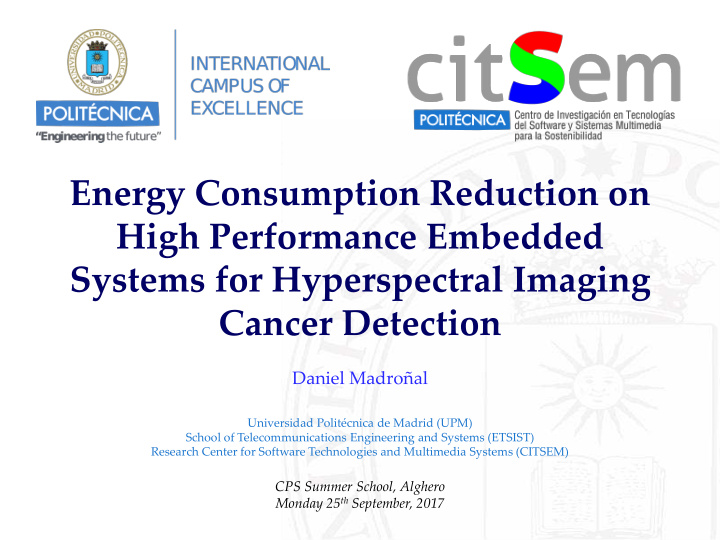



Energy Consumption Reduction on High Performance Embedded Systems for Hyperspectral Imaging Cancer Detection Daniel Madroñal Universidad Politécnica de Madrid (UPM) School of Telecommunications Engineering and Systems (ETSIST) Research Center for Software Technologies and Multimedia Systems (CITSEM) CPS Summer School, Alghero Monday 25 th September, 2017
Introduction PAPI Energy Reconfiguration estimation Real time Energy awareness D. Madroñal 2 Energy Consumption Reduction on High Performance Embedded Systems for Hyperspectral Imaging Cancer Detection
Procedure PAPI registers Total instructions Type of operations Memory ussage D. Madroñal 3 Energy Consumption Reduction on High Performance Embedded Systems for Hyperspectral Imaging Cancer Detection
Evaluation PAPI estimation Real measurements 18 18 Power (W) Power (W) 16 16 14 14 12 12 10 10 8 8 1 2 3 4 1 2 3 4 Workpoint Workpoint Reconfiguration D. Madroñal 4 Energy Consumption Reduction on High Performance Embedded Systems for Hyperspectral Imaging Cancer Detection
PhD Research – MPPA Platform 2 I/O (8 DMAs) 16 Clusters 256 PEs @ 400-500MHz I/O North PE PE PE PE DMA DMA DMA DMA Shared Memory (2 MB) PE PE PE PE 2GB DDR 2GB DDR PE PE PE PE DMA DMA DMA DMA PE PE PE PE I/O South D. Madroñal 5 Energy Consumption Reduction on High Performance Embedded Systems for Hyperspectral Imaging Cancer Detection
PhD Research – Preliminary Results STRESS Power (W) 16 100 29,14 SVM 15,18 14,55 Time (s) / Energy (J) 15 13,31 14 10 3,26 13 Power (W) 0,80 0,56 0,82 12 1 11 0,05 0,06 0,04 10 0,1 8,55 8,93 9 8 0,01 0-400-0 1-400-1 256-400-1 256-500-1 256-500-8 PEs / Freq / Total DMAs Power (W) Time (s) Energy (J) D. Madroñal 6 Energy Consumption Reduction on High Performance Embedded Systems for Hyperspectral Imaging Cancer Detection
Thank you for your attention daniel.madronal@upm.es D. Madroñal 7 Energy Consumption Reduction on High Performance Embedded Systems for Hyperspectral Imaging Cancer Detection
Recommend
More recommend